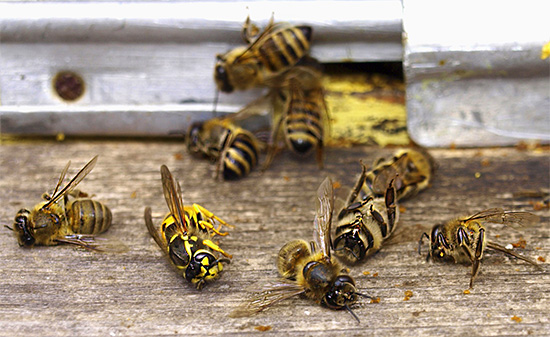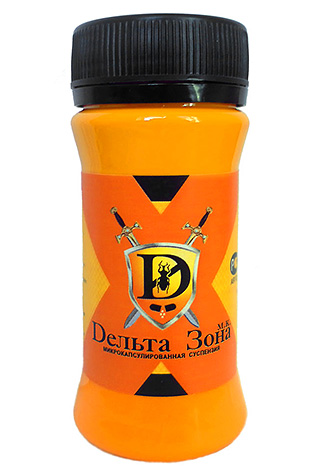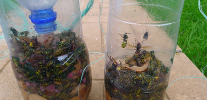
The apiary is the place where the wasps are among the most harmful insects. And if their presence in the summer cottage or garden can still be forgiven (after all, these winged carnivores destroy a large number of plant pests during the day), then in the apiary, destroying the bees, they cause only damage, and significant damage. That is why the fight with wasps in the apiary often becomes very relevant.

About how exactly you can save the bees from wasps, we will continue to talk ...
How dangerous wasps for apiary?
In order to effectively protect the bees from wasps, the beekeeper needs, as they say, “to know the enemy by sight”. For example, several species of wasps are the most dangerous for bees:
- Hornets - absolutely everything, without exception. Moreover, if the domestic species of these large wasps attack bees at a distance from their hives,then huge tropical hornets, arrive at the apiary as whole detachments and are capable of destroying a multi-thousand family of honey bees in just a few hours. A group of 40-50 giant hornets destroys an average bee family of 30-40 thousand individuals in about 3 hours.

- The philanthropist, also called the bee wolf, is a single medium-sized wasp that stores bees in the burrows for the subsequent feeding of its larvae. For the development of one larva, 5-6 bees are required. During the season, one female philanthropist thus destroys several dozen bees.

In addition, ordinary paper wasps are not averse to sometimes catching a bee, but this is given to them much more difficult - they are not “professional” hunters on bees, and they mostly extract injured and weakened insects. However, if the wasps in search of honey go to the hive, they can seriously damage and empty the honeycomb of the weakened family, which in the end can lead to its death.

At the same time, with the right approach, it is almost always possible to save bees from wasps. And with the implementation of such protection ahead of time, even before the beginning of predatory attacks on apiaries, you can completely avoid losses, and even for the whole summer you never see the sad picture of how wasps kill bees.
(The video posted at the end of the article clearly shows how the wasps can act in an organized and methodical manner against bees, attacking the hive).
Protecting the apiary ahead of time: what needs to be done in the spring?
Back in the spring, when the life of a bee colony is only entering the active phase, measures must be taken to protect the hive from the attacks of os: these protective measures must be comprehensive and thought out in advance to the smallest detail.

First, you should choose the right place for the apiary. Ideally, the terrain for this should be with dense chernozem soils, dense grass cover, lack of gullies, embankments and vacant lots with sandy or clay bald patches (it is in such areas that the female philanthropists make holes and carry the caught bees here).

If there are still small sandy areas near the apiary, it is useful to plow them even during the cold season, in order to reduce the number of philanthropists coming out of the minks to the ground in spring. Sometimes it helps to save a huge number of bees, because in the spring “bee wolves” simply will not breed.
Secondly, on the already located apiary around the perimeter of the territory it is useful to hang traps for wasps and hornetsmade from simple plastic bottles. It is not difficult to make such traps, and at the same time they protect bees very well.

For the manufacture of the trap, you need a regular plastic bottle: the upper third is cut off, the bait is poured at the bottom of the bottle, and the separated top is turned upside down and inserted into the bottom of the bottle. The wasps, attracted by the bait, climb into the trap through the neck, but are not able to get out.


As bait in traps, you can use jam (preferably fermented or soured), beer, kvass, brago. The more such traps will be placed in the apiary, the greater the number of bees will be able to save.
In addition, in the spring it is useful to pay attention to the emerging wasps and track their movements: sometimes it is even possible to find a wasp nest in a dense bush and to destroy it in a timely manner.
If the wasps are already robbing: methods of their destruction
If the wasps found an apiary, and the beekeeper noticed their attacks on the bees, then it is urgent to take additional measures to combat the attacking predators.
Additionally, bees can be protected by various methods:
- More thoroughly search for wasp nests in the vicinity of the apiary.

- Use special glue traps to protect the hive from wasps (for example, placed on the hive lid). A sweet, fermented bait is placed in the center of such glue traps. The wasps will first of all fly to this “dessert”, and then they simply will not be able to begin the hunt for bees, since they will firmly stick. For example, thanks to such traps, it is possible to overfill most of the hornets before they begin to rob.

Important!
When choosing a bait, you need to remember that bees can fly to sweet foods. That is why - to minimize the number of attracted bees - bait must be fermented.
- Manually catch and destroy philanthropists (usually there are not so many of them on the territory). Many beekeepers, seeing a flying philanthropist, will certainly try to destroy it - for example, they hit it with a special clapper made of a fine-meshed net. Regular and targeted fishing of philanthropists makes it possible to reliably protect bees from these wasps.

It is interesting
The bites of philanthropists are relatively painless and usually do not cause severe inflammation.Experienced “well-worn-out” beekeepers often just catch these wasps with their bare hands - in an adult man they are not able to pierce the skin on their palms with a sting.
In addition, as already noted above, beekeeping for fighting wasps is well helped by traps made from bottles. If in the spring they are hung out more for prevention, then with the mass appearance of wasps in the apiary the number of traps must be increased - the more they are, the more reliably it will be possible to protect the apiary.
Sometimes for a day in a two-liter bottle can fall up to hundreds of wasps and above.
How to find and destroy the hornet's nest?
Finding a hornet's nest in the forest or in rugged steppe terrain is a rather difficult task. It is good if it is located right near the apiary, and the beekeeper has the ability to detect it without additional funds. More often, the wasp's nest is located at a great distance, sometimes in inaccessible hollows or holes in the ground, and it can be very difficult to detect it without additional tricks.

An effective method of searching for wasp nests is to label insects. For this, the insect is caught with a net, on its “waist” a light and long red ribbon is neatly tied, after which the wasp is released.Usually within half an hour she returns to her nest, and thanks to a noticeable tape, it will be easy to follow. In this way, it is easy to detect even the hardly visible wasp nests on tall trees.
Wasps are destroyed in different ways. First, the nest can be burned by spilling it with gasoline or kerosene. However, if you decide to fight the wasps in this way, then you must strictly observe the relevant fire safety regulations. Always keep in mind that not only the nest itself can catch on fire, but objects located near it, for example, a tree branch or a roof of an economic building.

Secondly, the nest can be filled with water - for example, in the case when it is in an earthen hole (note that sometimes it may take several buckets of water). After the burrow is flooded, the entrance to it must be closed with a suitable-sized stone so that the wasps cannot get out.
Thirdly, the nest can be wrapped in a package, which is pre-poured powerful insecticide. If the nest is located in the hollow, then the insecticidal agent is simply poured into it, and the entrance to the hollow is clogged with a gag of fabric soaked in the same preparation.
As a poisoning drug, you can choose both somewhat outdated means - Aktar, Chlorofos, Karbofos, Chlorpyrifos, and more modern, less dangerous for humans, but very effective against wasps - Delta Zone, Get, Lyambda Zone, Xulsat Micro, etc.

It is desirable to destroy the nest at night, dressing so that the whole body is covered with thick clothes, and to protect the head, use a beekeeper's mask.

Despite the variety of options for dealing with wasps, perhaps the most reliable way to protect bees from them is to take care of hives and prevent the emergence of weak families. A strong bee family is quite capable of standing up for itself: wasps against bees protecting the hive with the whole family simply cannot do anything. Even hornets - and they are able to penetrate the hive only in exceptional cases.
On a note
Under natural conditions, the hornets are not able to destroy the family of bees. In most parts of our country, there are hornets of relatively small size, capable of catching only single bees. And in places where huge hornets live, local bees have a unique defense mechanism against them, called by scientists "heat ball" (bees massively stick around the hornet, creating a deadly temperature for it in the center of such a coil). Apiary tragedies happen when European bees, which are more effective in collecting honey, but do not have such protection as superfluous, are transported to Japan. There - if huge wasps attacked a hive - it is likely that the honey-bearing family will be completely destroyed.
The video below shows how wasps attack bees - there is practically no chance to stand against such an attack even for a thousand-strong bee colony ...
Interesting video: a group of several hornet attacks a beehive
And then the video shows the protection of bees from wasps. And here, a huge hornet, the most dangerous for bees. The organized defense of a strong family did not leave him a chance.
The bees destroyed the hornet, united together ...
Effective traps for wasps from improvised means: to help the beekeeper



